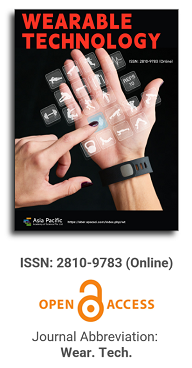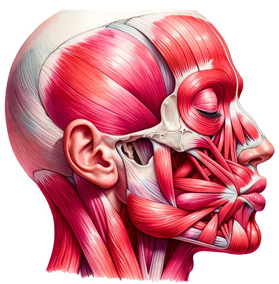

This paper delves deeply into the innovative realm of integrating human emotions with wearable technology. The primary focus is on the conceptualization and development of a kiss transfer device that harnesses the power of wearable technology to bridge the physical gap in human-human interactions. By investigating the intricate nuances of the human-human kissing process, the research seeks to replicate this intimate gesture through a technological medium. The paper not only elaborates on the anatomy, evolution, and hormonal dynamics of kissing but also underscores the transformative potential of wearable technology in capturing and transmitting these intimate moments. This exploration opens up new horizons for long-distance relationships, offering a tangible touchpoint that goes beyond traditional communication methods. Through this pioneering work, the research positions wearable technology as not just a tool for communication but as an extension of our human emotions and expressions.

Advancements in wearable sensor technology for enhanced diagnosis and management of Parkinson’s disease
Vol 6, Issue 1, 2025
Download PDF
Abstract
Parkinson’s disease (PD) is a progressive neurological disorder that gradually impairs bodily movements, making early diagnosis critical for slowing symptom progression and improving patients’ quality of life. As initial symptoms can be subtle, modern wearable sensor technologies play a vital role in monitoring patient movement and behavior. This review explores the applications of wearable sensors in diagnosing and managing Parkinson’s disease, drawing from 35 relevant studies published between 2015 and 2024. Findings indicate that 60%–80% of early-stage PD patients exhibit both motor and non-motor symptoms that can be effectively detected using motion sensors and electrophysiological methods, achieving approximately 90% accuracy in monitoring movement patterns. The incorporation of the Internet of Things (IoT) and machine learning has significantly enhanced the performance of these devices. Overall, wearable sensors are recognized as effective tools for early diagnosis and ongoing management of Parkinson’s disease, with the potential to improve patients’ quality of life and facilitate treatment processes. Future advancements should focus on developing smarter sensors and utilizing advanced algorithms for data analysis to maximize their clinical utility.
Keywords
References
- Brognara L, Palumbo P, Grimm B, Palmerini L, et al. Assessing gait in Parkinson’s disease using wearable motion sensors: A systematic review. Diseases. 2019; 7(1): 18.
- Albán-Cadena AC, Villalba-Meneses F, Pila-Varela KO, et al. Wearable sensors in the diagnosis and study of Parkinson’s disease symptoms: A systematic review. Journal of Medical Engineering & Technology. 2021; 45(7): 532–545.
- Di Biase L, Di Santo A, Caminiti ML, et al. Gait analysis in Parkinson’s disease: An overview of the most accurate markers for diagnosis and symptoms monitoring. Sensors. 2020; 20(12): 3529.
- Machrowska A, Karpiński R, Maciejewski M, et al. Application of Recurrence Quantification Analysis in the Detection of Osteoarthritis of the Knee with the Use of Vibroarthrography. Adv. Sci. Technol. Res. J. 2024; 18: 19–31.
- Karpiński R, Krakowski P, Jonak J, et al. Comparison of selected classification methods based on machine learning as a diagnostic tool for knee joint cartilage damage based on generated vibroacoustic processes. Applied Computer Science. 2023; 19(4): 136–150.
- Pulliam CL, Heldman DA, Orcutt TH, et al. Motion sensor strategies for automated optimization of deep brain stimulation in Parkinson’s disease. Parkinsonism & related disorders. 2015; 21(4): 378–382.
- Asci F, Vivacqua G, Zampogna A, et al. Wearable electrochemical sensors in Parkinson’s disease. Sensors. 2022; 22(3): 951.
- Machrowska A, Karpiński R, Maciejewski M, et al. Application of eemd-dfa algorithms and ann classification for detection of knee osteoarthritis using vibroarthrography. Applied Computer Science. 2024; 20(2): 90–108.
- Monje MH, Foffani G, Obeso J, Sánchez-Ferro Á. New sensor and wearable technologies to aid in the diagnosis and treatment monitoring of Parkinson’s disease. Annual Review of Biomedical Engineering. 2019; 21(1): 111–143.
- Muthukrishnan N, Abbas JJ, Krishnamurthi N. A wearable sensor system to measure step-based gait parameters for parkinson’s disease rehabilitation. Sensors. 2020; 20(22): 6417.
- Shawen N, O’Brien MK, Venkatesan S, et al. Role of data measurement characteristics in the accurate detection of Parkinson’s disease symptoms using wearable sensors. Journal of Neuroengineering and Rehabilitation. 2020; 17: 1–14.
- Sotirakis C, Su Z, Brzezicki MA, et al., Identification of motor progression in Parkinson’s disease using wearable sensors and machine learning. Parkinson’s Disease. 2023; 9(1): 142.
- Sica M, Varnosfaderani OT, Crowe CC, et al. Design of a multi-sensors wearable system for continuous home monitoring of people with Parkinson’s. IEEE Access. 2024.
- LeMoyne R, Mastroianni T, McCandless C, et al. Implementation of a smartphone as a wearable and wireless accelerometer and gyroscope platform for ascertaining deep brain stimulation treatment efficacy of Parkinson’s disease through machine learning classification. Advances in Parkinson’s Disease. 2018; 7(2): 19–30.
- Romero LE, Chatterjee P, Armentano RL. An IoT approach for integration of computational intelligence and wearable sensors for Parkinson’s disease diagnosis and monitoring. Health and Technology. 2016; 6: 167–172.
- De Oliveira APS, de Santana MA, Andrade MKS, et al. Early diagnosis of Parkinson’s disease using EEG, machine learning and partial directed coherence. Research on Biomedical Engineering. 2020; 36: 311–331.
- Oh SL, Hagiwara Y, Raghavendra U, et al. A deep learning approach for Parkinson’s disease diagnosis from EEG signals. Neural Computing and Applications. 2020; 32: 10927–10933.
- Chen M, Sun Z, Xin T, et al. An interpretable deep learning optimized wearable daily detection system for Parkinson’s disease. IEEE Transactions on Neural Systems and Rehabilitation Engineering. 2023.
- Prakash P, Kaur R, Levy J, et al. A deep learning approach for grading of motor impairment severity in Parkinson’s disease. In: Proceedings of the 2023 45th Annual International Conference of the IEEE Engineering in Medicine & Biology Society (EMBC); 24–27 July 2023; Sydney, Australia.
- Shcherbak A, Kovalenko E, Somov A. Detection and classification of early stages of Parkinson’s disease through wearable sensors and machine learning. IEEE Transactions on Instrumentation and Measurement. 2023; 72: 1–9.
- Patel S, Lorincz K, Hughes R, et al. Monitoring motor fluctuations in patients with Parkinson’s disease using wearable sensors. IEEE transactions on Information Technology in Biomedicine. 2009; 13(6): 864–873.
- Saikia A, Hussain M, Barua AR, Paul S. EEG-EMG correlation for Parkinson’s disease. International Journal of Engineering and Advanced Technology. 2019; 8(6): 1179–1185.
- Bikias T, Iakovakis D, Hadjidimitriou S, et al. DeepFoG: An IMU-based detection of freezing of gait episodes in Parkinson’s disease patients via deep learning. Frontiers in Robotics and AI. 2021; 8: 537384.
- Gonçalves HR, Rodrigues A, Santos CP. Gait monitoring system for patients with Parkinson’s disease. Expert Systems with Applications. 2021; 185: 115653.
- Antonini A, Reichmann H, Gentile G, et al. Toward objective monitoring of Parkinson’s disease motor symptoms using a wearable device: Wearability and performance evaluation of PDMonitor®. Frontiers in Neurology. 2023; 14: 1080752.
- Mughal H, Javed AR, Rizwan M, et al. Parkinson’s disease management via wearable sensors: A systematic review. IEEE Access. 2022; 10: 35219–35237.
- Zhang H, Li C, Liu W, et al. A multi-sensor wearable system for the quantitative assessment of Parkinson’s disease. Sensors. 2020; 20(21): 6146.
- Schepers M, Giuberti M, Bellusci G. Xsens MVN: Consistent tracking of human motion using inertial sensing. Xsens. Technol. 2018; 1(8): 1–8.
- Kim YW, Cho WH, Joa KL, et al. A new auto-scoring algorithm for balance assessment with wearable imu device based on nonlinear model. Journal of Mechanics in Medicine and Biology. 2020; 20(10): 2040011.
- Milano F, Cerro G, Santoni F, et al. Parkinson’s disease patient monitoring: A real-time tracking and tremor detection system based on magnetic measurements. Sensors. 2021; 21(12): 4196.
- Lu R, Xu Y, Li X, et al. Evaluation of wearable sensor devices in Parkinson’s disease: A review of current status and future prospects. Parkinson’s Disease. 2020; 1: 4693019.
- Heijmans MHM. Track and treat Parkinson’s disease using wearable sensors and MRI [PhD thesis]. Maastricht University; 2021.
- Jauhiainen M, Puustinen J, Mehrang S, et al. Identification of motor symptoms related to Parkinson disease using motion-tracking sensors at home (KÄVELI): Protocol for an observational case-control study. JMIR Research Protocols. 2019; 8(3): e12808.
- Moreau C, Rouaud T, Grabli D, et al. Overview on wearable sensors for the management of Parkinson’s disease. NPJ Parkinson’s Disease. 2023; 9(1): 153.
- Caballol N, Bayés À, Prats A, et al. Feasibility of a wearable inertial sensor to assess motor complications and treatment in Parkinson’s disease. PloS One. 2023; 18(2): e0279910.
- Hasan K, Biswas K, Ahmed K, et al. A comprehensive review of wireless body area network. Journal of Network and Computer Applications. 2019; 143: 178–198.
- Preethichandra DMG, Piyathilaka L, Izhar U, et al. Wireless body area networks and their applications—A review. IEEE Access. 2023; 11: 9202–9220.
- Poongodi T, Rathee A, Indrakumari R, Suresh P. IoT sensing capabilities: Sensor deployment and node discovery, wearable sensors, wireless body area network (WBAN), data acquisition. Principles of Internet of Things (IoT) Ecosystem: Insight Paradigm. 2020; 127–151.
- Dziadak B, Makowski Ł, Kucharek M, Jóśko A. Energy harvesting for wearable sensors and body area network nodes. Energies. 2023; 16(4): 1681.
- Dinov ID, Heavner B, Tang M, et al. Predictive big data analytics: A study of Parkinson’s disease using large, complex, heterogeneous, incongruent, multi-source and incomplete observations. PloS One. 2016; 11(8): e0157077.
Supporting Agencies
Copyright (c) 2025 Author(s)
License URL: https://creativecommons.org/licenses/by/4.0/

Prof. Zhen Cao
College of Information Science & Electronic Engineering, Zhejiang University
China, China
Processing Speed
-
-
-
- <5 days from submission to initial review decision;
- 62% acceptance rate
-
-
Asia Pacific Academy of Science Pte. Ltd. (APACSCI) specializes in international journal publishing. APACSCI adopts the open access publishing model and provides an important communication bridge for academic groups whose interest fields include engineering, technology, medicine, computer, mathematics, agriculture and forestry, and environment.





